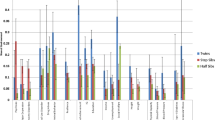Abstract
The assumption that genetic variance is primarily (if not all) additive is usually made in biometric-genetic analyses of data collected on twins raised together. It is known amongst those familiar with twin methods that this assumption may lead to overestimates of heritability and underestimates of shared environmental variance (E2), although this limitation is not always made clear to genetically naive readers of such applications. The concept of “emergenic” genetic mechanisms (a potentially extreme epistatic or nonadditive mechanism) discussed by Lykken (1982) raises the possibility that genetic variance may be substantially nonadditive in some applications. The aims of the present paper are to investigate quantitatively the potential size of such nonadditivity and such misestimations and to provoke discussion on the empirical plausibility (or otherwise) of epistatic effects. For if substantially present, the results of conventional twin analyses are substantially biased.
Similar content being viewed by others
References
Eaves, L. J. (1977). Inferring the causes of human variation.J. Roy. Stat. Soc. (Ser. A) 140:324–355.
Eaves, L. J., Last, K., Martin, N. G., and Jinks, J. L. (1977). A progressive approach to non-additivity and genotype-environmental covariance in the analysis of human differences.Br. J. Math. Stat. Psychol. 30:1–42.
Eaves, L. J., Last, K. A., Young, P. A., and Martin, N. G. (1978). Model-fitting approaches to the analysis of human behaviour.Heredity 41:249–320.
Feldman, M. W., and Lewontin, R. C. (1975). The heritability hang-up.Science,190:1163–1168.
Goldberger, A. S. (1977). Twin methods: A skeptical view. In Taubman, P. (ed.),Kinometrics: Determinants of Socioeconomic Success Between and Within Families, North-Holland, Amsterdam, Chap. 6.
Jardine, R., Martin, N. G., and Henderson, A. S. (1984). Genetic covariation between neuroticism and the symptoms of anxiety and depression.Genet. Epidemiol. 1:89–107.
Jinks, J. L., and Fulker, D. W. (1970). Comparison of the biometrical genetical, Mova, and classicall approaches to the analysis of human behaviour.Psychol. Bull. 75:311–349.
Lykken, D. J. (1982). Research with twins: The concept of emergenesis.Psychophysiology 19:361–373.
Martin, N. G., and Eaves, L. J. (1977). The genetical analysis of covariance structure.Heredity 38:79–95.
Plomin, R., and Daniels, D. (1987). Why are children in the same family so different from one another?Behav. Brain Sci. 10:1–60.
Wilson, S. (1982). Heritability.J. Appl. Prob. 19A:71–85.
Author information
Authors and Affiliations
Rights and permissions
About this article
Cite this article
Grayson, D.A. Twins reared together: Minimizing shared environmental effects. Behav Genet 19, 593–604 (1989). https://doi.org/10.1007/BF01066256
Received:
Accepted:
Issue Date:
DOI: https://doi.org/10.1007/BF01066256




